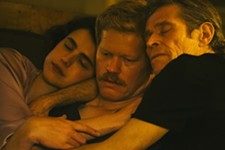Jeff Nichols' Intimate Portrait of a Marriage in Loving
Austin-based director on the pivotal civil rights case that inspired his film
By Richard Whittaker, Fri., Nov. 11, 2016
At the heart of Jeff Nichols' new film Loving, there's a picture. A couple on the couch, in a modest house in rural Virginia. His buzz-cut head is on her lap, his legs stretched out, so as to keep his work boots off the scuffed upholstery. She's got a cigarette in her left hand, perched over her wedding ring. They're both laughing, watching TV after a long day.
What makes the picture important is that what they were doing was illegal. Richard Loving was white. His wife, Mildred Loving, was black. In 1965, when Life magazine ran that photograph, the couple being together broke Virginia's laws banning interracial marriage. It was the lawsuit bearing their name, Loving v. Virginia, that ended miscegenation laws nationwide. But for Nichols, their story isn't about trial dates and Supreme Court hearings. He said, "It's about marriage, and commitment."
Austin-based Nichols first heard about their story in the most prosaic way possible – the producers emailed him. Documentarian Nancy Buirski made The Loving Story for HBO, and they were interested in turning it into a narrative feature. Nichols' initial reaction was surprise that he had never heard of the Loving suit before. He said, "That seemed wrong, that I wouldn't know about a story like this. That this landmark civil rights Supreme Court decision isn't taught in schools, [that] it's not understood. That bothered me."
It's one of the pivotal cases in the history of equal rights in America. In 1958, 18-year-old Mildred Jeter (Ruth Negga, Preacher) and 22-year-old Richard Loving (Joel Edgerton, The Gift) traveled from Central Point, Va., to Washington, D.C., to be married. After returning home, they were arrested and convicted of violating the state's Racial Integrity Act of 1924. Rather than go to jail, they took the judge's offer of leaving the state, but finally grew tired of this exile, and challenged the ruling and the law all the way to the U.S. Supreme Court.
Or rather, the American Civil Liberties Union did. Nichols described the Lovings themselves as "apolitical. ... I'm watching this documentary, I went, 'Oh, these people have nothing to do with this court case. They're the inciting incident, but in terms of the day-to-day, this isn't a courtroom drama.' Well, good, because I don't want to make that [film]."
The story was his way of approaching something inauthentic about many civil rights dramas, where simplistic lines are drawn, and metaphor drowns out reality. Instead, he drew on his own family's experiences in Arkansas, where the law was one thing, but the reality of farming life was another. Skin color seems a lot less important when you've got a tractor that needs fixing, or a crop to pick before the first frost. "When I grew up, listening to my dad talking about growing up poor in the South in the Forties, Fifties, and Sixties, it was, 'We just always depended on one another.' Yes, absolutely there was segregation and separate bathrooms and water fountains and lunch counters and all of those destructive things, and much worse. But it seemed like nobody had ever talked about the codependence of these two communities."
While he avoids metaphors within the narrative, Nichols sees the era's segregationist instincts as worryingly analogous to modern political discussions in Texas. "We have these people trying to wave wands and deport people. Don't you understand that our lives are connected?"
Aside from being Nichols' first overtly political film, Loving is also his first period piece. That created a fresh challenge for the director, who has specialized in making recognizable but somehow fantastical worlds. He said, "I can walk on the film set for Midnight Special and look at a motel and say, 'This isn't right.' But I can't walk onto this film set and do that."
He credited production designer Chad Keith and costume designer Erin Benach with keeping him "period correct." However, this was also an opportunity to broach another inauthenticity. In re-creating the postwar era, he said, many films end up "kind of bubble gum, and a big part of that is the cars. When you're making a period film, you reach out to all these car clubs, and these guys turn up with their period-correct cars, and they're all really shiny, because they've been polishing them with a diaper every weekend."
Just as Buirski's HBO film brought him to the story, so the period footage she used – much of it shot by pioneering female documentarian Hope Ryden – showed him how wrong that sparkling vision was. After a couple of years of driving with sun-beaten Fifties paint down Virginia back roads, a car would "look like shit," said Nichols, "so the first thing we did was we took all these cars and we dulled them all." He took the same approach with clothing: "I just felt that you needed to sit on it for a little bit, and everything needs to look lived in."
While a political period piece may be a change of pace for Nichols, in many ways, Loving harkens back to his breakout sophomore success Take Shelter. Both focus on a plain-speaking rural couple being subjected to "this giant power outside of their perspective, that is forcing itself upon them." In Take Shelter, that's prophetic visions plaguing farmer Curtis LaFourche (Michael Shannon, who appears in Loving as Life photographer Grey Villet). Here it's the law plaguing Richard Loving: While Mildred is determined to fight the good fight, he just wants to get on with his life. For Nichols, that's representative of the rural existence, where so much of day-to-day behavior is dictated by the turn of the season and the length of the day. He said, "That rhythm, that structure, maybe that feeds that libertarian approach in the South. 'Just leave us alone.' Not 'Leave us alone because how dare you try to infringe on our rights.' It's more, 'Leave us alone, we have stuff to do.'"
Writing the part created a specific challenge. Call it the Mr. Smith Goes to Washington effect, where audiences expect a valiant and nuanced speech from their blue-collar protagonist. That just wasn't Loving. He wasn't a backwoods philosopher. He was a brick layer with little formal education who made money on the side as a mechanic for illegal drag racers. In every scene, Nichols said, the question was "How much is he understanding this? Which scenes does he not understand what's being talked about, and is just this blunt, dull thing? How many scenes does he completely understand what's going on, but is incapable of enunciating his frustrations?"
Nichols called that "a dangerous place for an actor to be. ... Joel's walking this incredibly tricky tightrope, to navigate a character that is identifiable but at the same time true to the intellect and the socioeconomic status that's being represented."
Yet in many ways, Richard Loving is an archetypal Nichols male protagonist – pragmatic, stoic, measured, taciturn. His scripts are as recognizable for their silences as for their words. He's at odds with many scriptwriters who write as though the story only begins with the first spoken line. "Well, I disagree with that approach," said Nichols. "I think, any time a character is onscreen, there's behavior, and dialogue is just an extension of behavior. So I guess what I've given them is behavior throughout."












